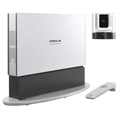PCS-G50
- High-Quality Video/High-Speed Network Connection
The PCS-G50 provides excellent picture quality over both ISDN (H.320) and IP (H.323) networks and fully supports the latest non-proprietary ITU-T H.264 video codec standard for maximum customer confidence and flexibility. When video encoding is in accordance with the H.263 protocol, the PCS-G50 supports the 4CIF format at a maximum frame rate of 30 fps, and when in H.264 protocol, it supports the interlaced SIF format at 60 fields per second. In addition, the PCS-G50 can achieve a maximum bandwidth of 4 Mb/s with an IP connection, and up to 768 Kb/s with an ISDN connection using an optional PCSA-B768S ISDN unit. This combination of high-quality codec and high-speed network support provides video quality comparable to standard TV broadcasts. The PCS-G50P supports a maximum of 50 fields per second in interlaced SIF format. - Multi-Point Video Conferencing at up to 10 Sites
Using optional MCU software, the PCS-G50 can be configured to communicate with up to 5 remote videoconferencing sites (6 sites total) simultaneously using either an IP (H.323 protocol) or ISDN (H.320 protocol) connection. It can also support videoconferences in which the connections are a combination of IP and ISDN using a unique bridging function. And because the PCS-G50 has a "speedmatching" function, it maximizes performance by not reducing the higher speed connection to match the lower speed connection, as is done with some videoconferencing systems. Moreover, two PCS-G50 units - each installed with the optional MCU (H.323) software - can be cascaded with an IP connection to support a maximum of 10 simultaneous sites. What is unique about the PCS-G50 is that it provides high quality, H.264 CIF video and clear MPEG-4 AAC audio, even in a multi-point videoconference. And of course, the PCS-G50 allows users to expand from a peer-to-peer videoconference to a multi-point videoconference. When adding a new endpoint on the same network (IP or ISDN), the system will default to the lowest resolution video standard of all endpoints. - Site-Name Display
During multi-point videoconferences, it can be difficult to keep track of all of the participants; however, with the PCS-G50 site-name display function, this is no longer the case. The PCS-G50 can display anything from company or branch names to geographical locations on a monitor, allowing videoconference participants to keep track of all parties. - Flexible Display Patterns at all Sites
In addition to conventional patterns of display—such as showing the far-end site on a full screen or displaying near-end and far-end sites in picture-in-picture mode—a variety of other display patterns are available with the Sony PCS-G50. Supporting both 4-screen and 6-screen continuous-presence modes, the PCS-G50 can display the most appropriate pattern to match the number of sites that are connected. In both full-screen and continuous-presence modes, the following two display options are available:.- Voice Switching
The PCS-G50 defaults to voice switching, which displays the far-end site that is actively talking on the monitor when the unit is in full-screen mode. In continuous-presence mode, the site that is actively speaking is displayed on the largest of the six sub screens, and the near-end site is displayed on the sub screen where the original far-end site was. - Fixed Site
As its name suggests, the selected far-end site is continuously displayed on the monitor when the unit is in full-screen mode. In continuous-presence mode the selected far-end site is displayed in the largest of the six sub screens, and the other sites are fixed as well.
- Voice Switching
- Audio Visual (A/V) Recording to Memory Stick Media
Capturing audio and video during a videoconference is important to keep a record of what was conveyed during a conference. With the PCS-G50, audio and video displayed on the main monitor can be recorded directly to Memory Stick media in MPEG-4 format and can be played back on any PC using QuickTime media player. AV recording is not supported when AES is active. Also, graphical data cannot be recorded. - Data-Sharing Capabilities/Digital Whiteboard Support
Data originated on your PC can be shared with your videoconferencing counterparts, making communication even more effective. Any image that can be displayed on a PC can be sent or received in native XGA resolution, allowing all parties to share data during a videoconference. In addition, information drawn up on a digital whiteboard can also be viewed in real time by all parties participating in a videoconference or captured and stored for later reference. Sending data requires the optional PCSA-DSB1S Data Solution Box (DSB); however, the DSB is not required for receiving data. - Superb Sound
The Sony PCS-G50 reproduces clear and natural-sounding audio using MPEG-4 AAC (Advanced Audio Coding) at 14 KHz. A built-in echo cancellation system minimizes unwanted echoes during a video conference. The Sony PCS-G50 is also compatible with a number of SONY external microphones and speakers, including unidirectional and omnidirectional models. Professional A/V integrators will particularly appreciate the power and flexibility of this system to be customized for best application match. For exceptional sound quality in rooms with conference tables in a U-shape or in a classroom layout, the optional unidirectional PCSA-A7 microphone is ideal. Up to 40 units can be daisy chained to ensure that all participants sitting near a microphone can be heard. - Stylish Design
With its elegant design and optional stands for both the camera unit and the codec unit, the PCS-G50 can fit into even the classiest of conference rooms - Easy-to-Use Remote Commander Unit/Intuitive GUI
The Sony PCS-G50 has a number of features that make it easy to operate. The cursor keys on the Remote Commander unit can be used to select and call any one of three contacts, which are pre-programmed and displayed in the Launcher Menu. Up to 500 contacts can be stored in the PCS-G50 common address book for quick and easy dialing. In addition, the unit supports a call history log, which stores the last 32 incoming and outgoing calls so that the user can readily select and dial a recent contact. - Memory Stick Support
Private phone books can be created and stored on Memory Stick media. By simply inserting the Memory Stick media into the PCS-G50, the unit automatically recognizes and activates the private phone book, thereby eliminating the need to re-enter contact information to place a call. Memory Stick media has a number of other uses, such as storing captured images, PC-generated data, and digital whiteboard drawings. The media can also be used for installing and updating software. In addition to Memory Stick, Memory Stick PRO (TM) and Memory Stick DUO (TM) with an adaptor can be used. - Secure Video Conferencing - Advanced Encryption Standard (AES)
Secure video conferencing over a network is possible because the Sony PCS-G50 supports AES Encryption, a NIST (National Institute of Standards and Technology) standard for encrypting electronic data used in commercial applications including telecommunications. When a videoconference is initiated with the AES feature active, video, audio, and graphics are encrypted for the duration of the videoconference. Because of this feature, companies can hold sensitive meetings, negotiations, and other similar interactions with confidence that they will not be compromised. - QoS (Quality of Service) Enhancement Functions
When holding a video conference over a network, a common concern is how to maintain video and audio quality when the performance of the network is changing. The PCS-G50 provides three advanced functions to enhance QoS over a network: - Forward Error Correction (FEC)
The Sony PCS-G50 employs an FEC function that corrects errors in transmission at the receiving end. If a transmission error occurs, the PCS-G50 can repair the data and accurately reproduce the original audio and video. - Adaptive Rate Control (ARC)
The adaptive rate control function automatically varies the video data transfer rate to meet changing network conditions. It also selects the most appropriate frame rates, which helps prevent audio and video breakup. - Real-time Auto Repeat Request (ARQ)
The real-time ARQ function recovers lost IP packets. This is achieved by buffering the packets at the encoder and resending any that are lost. This feature helps maintain audio and video quality, and helps prevent picture collapse even under high network traffic conditions.
- High-Quality Video H.263 4-CIF/High-Speed network connection up to 4 Mb/s
- Multi-Point videoconferencing at up to 10 sites
- Site-Name display
- Flexible display patterns at all sites
- Audiovisual (A/V) recording to Memory Stick media
- Data-Sharing Capabilities/Digital whiteboard support
- Superb sound MPEG-4 AAC
- Stylish design
- Easy-to-Use remote commander Unit/Intuitive GUI
- Memory stick support
- Secure videoconferencing - advanced encryption standard (AES)
- Forward error correction (FEC)
- Adaptive rate control (ARC)
- Real-time auto repeat request (ARQ)
Video Signal system
NTSC
Video Standards
H.261 (Annex D), H.263 (Annex D,F), H.263+ (Annex J), H.263++ (Annex U,W), H.264, MPEG-4 SP@L3, H.239 Video and Presentation Data Support*
Video Resolution
SQCIF (128 x 96, reception only), QCIF (176 x 144), CIF (352 x 288), 4CIF (704 x 576, H.263 only), Interlaced SIF (H.263, H.264 only)
Video Frame rate Max. 30 frames/s (H.261, H.263, H.263+, H.263++, H.264, and MPEG-4 SP@L3), Interlaced SIF Mode (60 fields/s)
Video Bit rate Up to 4 Mb/s in H.323 (Incl. audio)**, Up to 768 Kb/s in H.320 (Incl. audio) when configured with the PCSA-B768S, Up to 384 Kb/s in H.320 (Incl. audio) when configured with the PCSA-B384S
Audio Bandwidth and coding.
G.711: 3.4 kHz at 56/64 Kb/s, G.722: 7.0 kHz at 48/56/64 Kb/s, G.722.1: 7.0 kHz at 24/32 Kb/s (H.323), G.728: 3.4 kHz at 16 Kb/s, G.723.1: 3.4 kHz at 5.3/6.3 Kb/s (H.323), G.729: 3.4 kHz at 8 Kb/s (H.323), MPEG-4 AAC (mono) 14 kHz at 64/96 Kb/s (H.323) at 48 Kb/s (H.320)
Audio Echo cancellation
Noise Suppressor included, Automatic Gain Control included
Graphics XGA
1024 pixels x 768 lines (H.263), with PCSA-DSB1S
Graphics 4CIF
704 pixels x 576 lines (H.261 Annex D and H.263) Picture in Picture Sub screen size 4.3” (256 x 192), One of four corners ITU-T Standards (excludes audio/video standards) H.320, H.323, H.221, Bonding, H.281 FECC, H.225.0, H.242, H.243, H.245, T.120
Network Protocols
TELNET (Server), HTTP (Server), FTP (Server), SNMP (Agent), DNS (Client), DHCP (Client), RTP/RTCP, TCP/UDP, ARP, SIP
Multipoint Capabilities
Up to 6 sites (H.320/H.323)***
Up to 10 sites (H.320/H.323)****
Lip Synchronization
Manual On/Off
Camera Unit
Image device: 1/4 type CCD
Horizontal resolution
470 TV lines
Focal length
3.1 to 31 mm (F1.8 to 2.9)
Focus
Auto/Manual
IRIS
Auto
Zoom ratio
x10 Optical zoom (x40 with digital zoom)
Pan angle
-100 =< to +100 =< (Max. 100 =</sec)
Tilt angle
-25 =< to +25 =< (Max. 125 =</sec)
Preset
Up to 6 positions
S/N
More than 50 dB
Others Back light compensation Auto white balance Remote Commander
Format
Wireless SIRCS
Interfaces
Communication Terminal
Video
D-Sub 15-pin Dedicated Camera I/F x1
S-video or Composite input x1 (switchable with conversion connector)
S-video output x2 (for main/sub monitor)
Composite output (AUX)
RGB output
Audio
Line input RCA
AUX input RCA (bypassess echo cancellor)
External analog microphone input, Mini-jack (Plug in power) x2
External digital microphone input x2
Line output RCA x2 (one mixed output)
Network
10Base-T/100Base-TX
External ISDN Unit I/F
Control
SIRCS IR Out x2
Wired SIRCS In (Control-S)
RS-232C
DSB I/F
Dedicated D-Sub 15
RGB I/F
RGB output
Memory Stick
Memory Stick slot
Digital whiteboard
Dedicated connector
Interfaces (Camera Unit)
Video
IR for DS150
Terminal.
Dedicated 23-pin
AUX camera.
8-pin Mini-DIN
Sony PCS-G50 General Specifications
Operating temperature
5 =<C to 35 =<C
Operating humidity
30% to 70%
Storage temperature
-20 =<C to +55 =<C
Storage humidity
25% to 75%
Power Requirements
AC 120 V, 50/60 Hz
Power Consumption
DC 19.5 V, 5 A
Communication Terminal Dimensions (W x H x D)
420 x 66 x 256 mm (16 5/8 x 2 5/8 x 10 1/8 inches), excl. projections
Camera Unit Dimensions (W x H x D)
131 x 141 x 130 mm (5 1/4 x 5 5/8 x 5 1/8), excl. projections
Remote Commander Dimensions (W x H x D)
47 x 43 x 195 mm (1 7/8 x 1 3/4 x 7 3/4 inches), excl. projections
Communication Terminal Mass
4.6 kg (10 lbs 2 oz)
Camera Unit Mass
1.0 kg (2 lbs 3 oz)
Remote Commander Mass
180 g (6.3 oz), incl. batteries
Supplied Accessories
- Conference Microphone
- Camera Unit x 1 ( includes dedicated 3m cable )
- Remote Commander Unit x 1
- AC Adaptor/Power Cord x 1
- Omnidirectional Microphone (PCS-A1) x 1
- IR Repeater x 2
- Manganese Battery for Remote Commander x 2
- Operation Manual x 1
- Operation Guide x 1
- Quick Connection Guide x 1
- Cable Connection Guide x 1
- Worldwide Warranty Booklet x 1
- Audio Cable ( 1.0 m ) x 1
- S-Video Cable ( 1.5 m ) x 1
- Mini DIN 7-pin to RCA Conversion Connector x 1
Supplied Accessories
| Model: | Description: |
|---|---|
| PCSASTMG70 | Codec Stand For Pcs-G70 |
| PCSAB384S | Isdn Bri 384kbps Interface Box (Black) |
| PCSACG70C7M | Camera Extension Cable 7m for G70 |
| PCSASTCG70 | Camera Stand For Pcsa-Cg70 |
| EVID70 | Pan/Tilt/Zoom Color NTSC Video Camera |
| PCSAPRI | ISDN PRI Interface Box (Black) |
| PCSAM3G50 | H.323 Mcu Software |
| PCSAA3 | Directional Tabletop Microphone |
| PCSAA7P4 | Noise Canceller Mics For G50/70, HG90 and XG80 (4 Units Set) |
| PCSAB768S | Isdn Bri 768kbps Interface Box (Black) |
| PCSA1 | Conference Microphone |
| PCSAM0G50 | H.320 Mcu Software |
| BRC300 | NTSC 1/4.7 3CCDs P/T/Z Color Video Camera |
| EVID100 | PAN/TILT/ZOOM COLOR VIDEO CAMERA |
| PCSADSB1S | Data Solution Box (Silver) |
| EVID70/W | P/T/Z Color Video Camera - White Version |
Brochure


